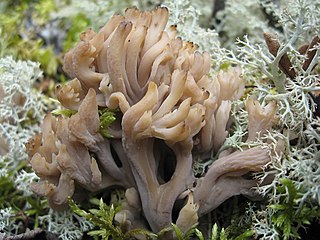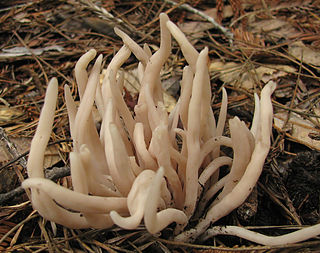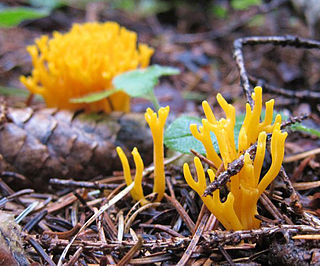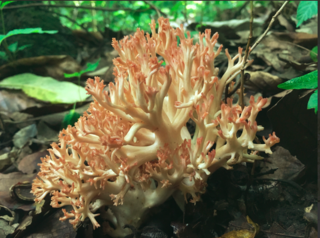
The Clavariaceae are a family of fungi in the order Agaricales. Originally the family contained most of the clavarioid fungi, but in its current sense is more restricted, albeit with a greater diversity of basidiocarp forms. Basidiocarps are variously clavarioid or agaricoid (mushroom-shaped), less commonly corticioid or hydnoid.

Clavulina cristata, commonly known as the wrinkled coral fungus, white coral fungus or the crested coral fungus, is a white- or light-colored edible coral mushroom present in temperate areas of the Americas and Europe. It is the type species of the genus Clavulina.

Ramariopsis is a genus of coral fungi in the family Clavariaceae. The genus has a collectively widespread distribution and contains about 40 species. The name means 'having the appearance of Ramaria'.

Ramariopsis kunzei is an edible species of coral fungi in the family Clavariaceae, and the type species of the genus Ramariopsis. It is commonly known as white coral because of the branched structure of the fruit bodies that resemble marine coral. The fruit bodies are up to 5 cm (2.0 in) tall by 4 cm (1.6 in) wide, with numerous branches originating from a short rudimentary stem. The branches are one to two millimeters thick, smooth, and white, sometimes with yellowish tips in age. Ramariopsis kunzei has a widespread distribution, and is found in North America, Europe, Asia, and Australia.

Ramaria botrytis, commonly known as the clustered coral, the pink-tipped coral mushroom, or the cauliflower coral, is an edible species of coral fungus in the family Gomphaceae. Its robust fruit body can grow up to 15 cm (6 in) in diameter and 20 cm (8 in) tall, and resembles some marine coral. Its dense branches, which originate from a stout, massive base, are swollen at the tips and divided into several small branchlets. The branches are initially whitish but age to buff or tan, with tips that are pink to reddish. The flesh is thick and white. The spores, yellowish in deposit, are ellipsoid, feature longitudinal striations, and measure about 13.8 by 4.7 micrometers.

The clavarioid fungi are a group of fungi in the Basidiomycota typically having erect, simple or branched basidiocarps that are formed on the ground, on decaying vegetation, or on dead wood. They are colloquially called club fungi and coral fungi.

Clavaria fragilis, commonly known as fairy fingers, white worm coral, or white spindles, is a species of fungus in the family Clavariaceae. It is synonymous with Clavaria vermicularis. The fungus is the type species of the genus Clavaria and is a typical member of the clavarioid or club fungi. It produces tubular, unbranched, white basidiocarps that typically grow in clusters. The fruit bodies can reach dimensions of 15 cm (6 in) tall by 0.5 cm thick. There are several similar coral-like fungi.

Clavaria zollingeri, commonly known as the violet coral or the magenta coral, is a widely distributed species of fungus. It produces striking tubular, purple to pinkish-violet fruit bodies that grow up to 10 cm (3.9 in) tall and 7 cm (2.8 in) wide. The extreme tips of the fragile, slender branches are usually rounded and brownish. A typical member of the clavarioid or club fungi, Clavaria zollingeri is saprobic, and so derives nutrients by breaking down organic matter. The fruit bodies are typically found growing on the ground in woodland litter, or in grasslands. Variations in branching and color can often be used to distinguish C. zollingeri from similarly colored coral fungi such as Alloclavaria purpurea and Clavulina amethystina, although microscopy is required to reliably identify the latter species.

Clavaria fumosa, commonly known as the grayish fairy club, smoky clavaria or smoky spindles, is a species of coral fungus in the family Clavariaceae. It was originally described by Christian Hendrik Persoon in 1795.

Ramariopsis pulchella is a species of coral fungus in the family Clavariaceae. Originally named Clavaria pulchella by Jean Louis Émile Boudier in 1887, the species was transferred to Ramariopsis by E.J.H. Corner in 1950. The fungus has a cosmopolitan distribution.

Clavulina ornatipes is a species of coral fungus in the family Clavulinaceae. First described as Clavaria ornatipes by Charles Horton Peck in 1908, it was transferred to Clavulina by E.J.H. Corner in 1950.
Clavulina puiggarii is a species of coral fungus in the family Clavulinaceae. It is found in Australia and Brazil.

Calocera viscosa is a species of fungus in the family Dacrymycetaceae. In the UK, it has the recommended English name of yellow stagshorn. In North America it is variously called coral jelly fungus, jelly staghorn, yellow false coral, yellow tuning fork, and jelly antler. Basidiocarps are gelatinous, bright golden yellow, and branched. It grows exclusively on logs and dead wood of conifers. Calocera viscosa is a common species throughout Europe and has also been recorded from North America, Asia, and Australia.

Clavulinopsis umbrinella, commonly known as the beige coral, is a coral mushroom in the family Clavariaceae. Fruit bodies are initially white before turning pale brown with darker brown tips. Originally described in 1860, it is known to occur in Europe and North America where it grows in grass. It is not a common species.

Ramaria cystidiophora, commonly known as the fuzzy-footed coral, is a coral mushroom in the family Gomphaceae. It is in the Laeticolora subgenus of Ramaria. The branches are yellow, sometimes brighter at the tips, growing from a fuzzy white stem. The odour is sweet.

Ramaria subbotrytis is a species of coral fungus in the family Gomphaceae. It was previously classified in the family Ramariaceae, and before that in the genus Clavaria, family Clavariaceae. It was originally described as Clavaria subbotrytis by William Chambers Coker in 1923 from collections made in North Carolina. E.J.H. Corner transferred it to the genus Ramaria in 1950.

Ramaria gracilis is a species of coral fungus in the family Gomphaceae.

Clavulina vinaceocervina var. avellanea is a variety of the Clavulina vinaceocervina species. It has been previously described as characterised by its fleshy brown to violaceus tan colour, contrasting the typical variety of Clavulina vinaceocervina, Clavulina vinaceocervina var. vinaceocervina, which has a pinkish-rosy colour. Observations of Clavulina vinaceocervina var. avellanea since, however, have also shown a pinkish-rosy colour.

Clavulina vinaceocervina var. vinaceocervina is a variety of the Clavulina vinaceocervina species. The knowledge regarding this variety is currently limited. The other variety of this species is Clavulina vinaceocervina var. avellanea.
Nymphaea nouchali var. versicolor is a variety of the water lily species Nymphaea nouchali Burm.f. naturally found in tropical Asia.
















